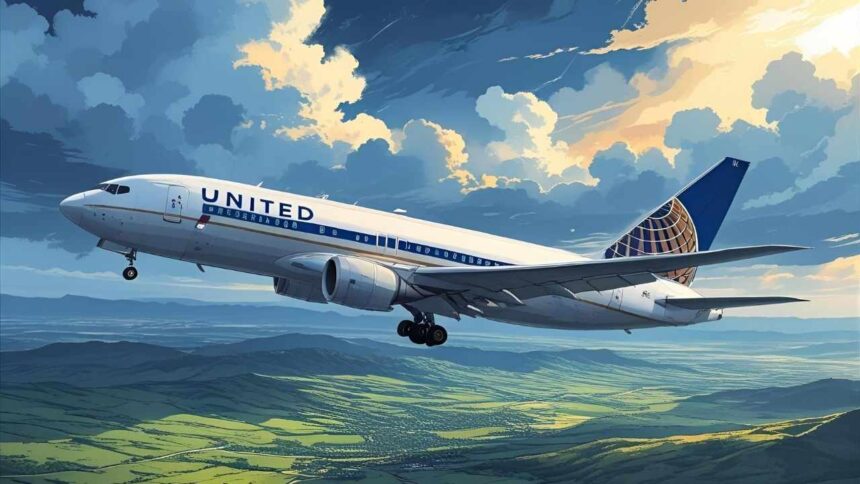A Routine Flight Turns Chaotic
It was supposed to be just another Tuesday afternoon flight from Newark to San Francisco. Passengers aboard United Airlines Flight UA770 had settled in for the 5-hour journey, some dozing off, others watching movies, completely unaware of the drama about to unfold at 35,000 feet.
At approximately 2:47 PM EST, about three hours into the flight, the Boeing 777-200 suddenly jolted violently. A loud “boom” reverberated through the cabin, followed by an unsettling vibration that had passengers gripping their armrests.
“I thought we’d been hit by something,” recalled passenger Daniel Chen, a tech executive from Palo Alto. “The entire plane shook like we were driving over potholes, but we were in the air!”
The Critical Moments: How the Crew Responded
Within seconds of the incident, the flight crew sprang into action with textbook precision:
✔ Immediate Systems Check: First officers began running through emergency checklists
✔ Passenger Reassurance: The captain’s voice came over the PA system calm but firm: “Ladies and gentlemen, we’re experiencing some technical difficulties…”
✔ Emergency Declaration: At 2:51 PM, the crew declared an emergency with air traffic control
Air traffic control recordings later revealed the tense exchange:
UA770: “Denver Center, United 770 declaring emergency, requesting immediate diversion.”
ATC: “United 770, Denver Center, roger your emergency. Heading 270, descend and maintain FL240.”
The Science Behind the Scare: What Went Wrong?
Aviation experts have identified several potential culprits for the UA770 incident:
1. Engine Compressor Stall (Most Likely)
-
Characterized by loud bangs and vibration
-
Caused by disrupted airflow through the engine
-
The Boeing 777’s GE90 engines are extremely reliable but not infallible
2. Hydraulic System Malfunction
-
Could explain the control difficulties reported
-
Modern aircraft have multiple redundant systems
3. Severe Clear Air Turbulence
-
Unpredictable and dangerous
-
Can cause sudden altitude drops
Interesting Fact: The Boeing 777 has one of the best safety records of any commercial aircraft, with just 0.06 fatal accidents per million flights.
Passenger Experience: 90 Minutes of Tension
As the aircraft descended toward Denver International Airport, the cabin atmosphere grew increasingly tense:
-
Flight attendants moved swiftly to secure the cabin
-
Oxygen masks remained stowed (a good sign)
-
Some passengers reported smelling burnt oil
-
The captain provided updates every 10 minutes
“We could see the Rockies coming into view,” said school teacher Melissa Grady. “Normally that would be beautiful, but all I could think was ‘please let us get down safely.'”
The Landing: A Textbook Emergency Approach
At 3:22 PM MST, UA770 made what passengers described as “the smoothest hard landing they’d ever experienced”:
-
Emergency vehicles followed the aircraft down the runway
-
The plane came to a stop well before the runway’s end
-
A loud cheer erupted through the cabin
-
Flight attendants maintained professionalism throughout
Aftermath: United’s Response and Compensation
United Airlines’ crisis response team swung into action:
Within 1 hour:
-
All passengers deboarded safely
-
Airport staff provided water and snacks
-
Customer service reps began rebooking flights
Within 4 hours:
-
80% of passengers were on new flights
-
Hotel vouchers distributed for those needing overnight stays
-
Meal allowances provided
Within 24 hours:
-
United issued $500 travel vouchers to all passengers
-
Established a dedicated customer service line
-
Began full aircraft inspection
Aviation Safety: Why This Incident Matters
While dramatic, the UA770 emergency actually highlights several positive aspects of modern aviation:
-
Crew Training Works: The flawless response proves the value of rigorous simulator training
-
Aircraft Redundancy Saves Lives: Multiple backup systems prevented a minor issue from becoming catastrophic
-
ATC Coordination is Seamless: The quick diversion to Denver shows the efficiency of air traffic control networks
Lessons for Future Travelers
As someone who flies over 100,000 miles annually, here’s my advice:
-
Always Pay Attention to Safety Briefings – Yes, even the ones you’ve heard a hundred times
-
Keep Important Items Accessible – Medications, passports, and chargers should be within easy reach
-
Choose Your Seat Wisely – Exit rows offer quicker access in emergencies
-
Consider Travel Insurance – Especially for international flights
The Investigation: What We’re Waiting to Learn
The NTSB has launched a full investigation, with key questions remaining:
-
What exactly caused the initial bang and vibration?
-
Were there any maintenance red flags beforehand?
-
How close was this to being a more serious incident?
United has pledged to release preliminary findings within 30 days.
Final Thoughts: A Reminder of Aviation’s Safety
While the UA770 incident made headlines, it’s crucial to remember that air travel remains the safest mode of transportation. What could have been a tragedy became instead a masterclass in professional crisis management – from the pilots to the flight attendants to ground crews.
As passenger Michael Ruiz put it: “It was scary, but it showed me how many layers of protection there are when you’re in the air.”
Your Thoughts? Have you ever experienced an in-flight emergency? Share your story in the comments below!





